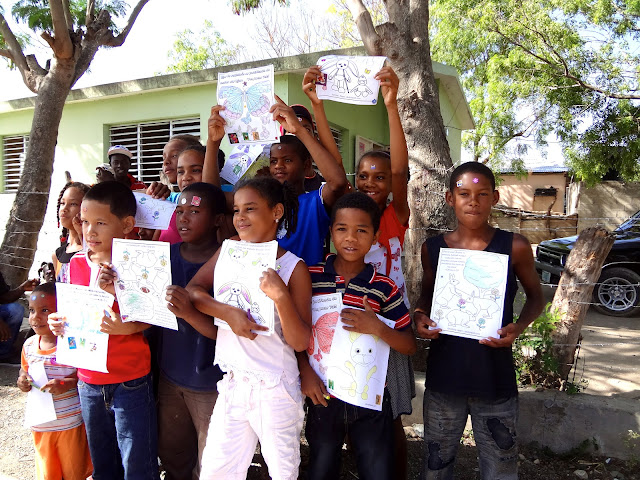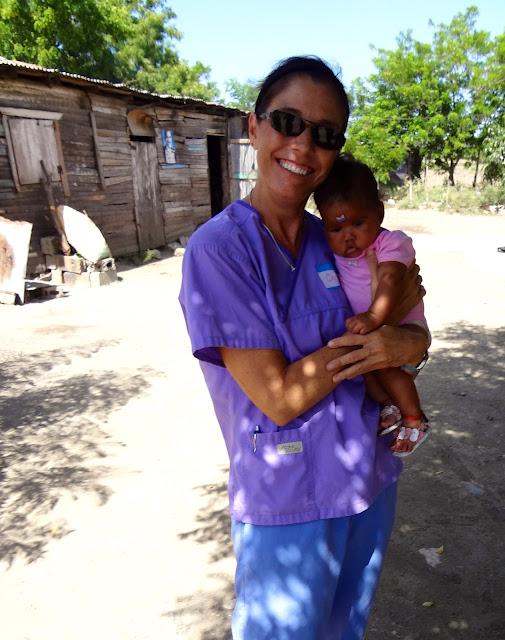I recently read a book called Toxic Charity: http://www.amazon.com/Toxic-Charity-Churches-Charities-Reverse/dp/0062076205
The book had a profound impact on me as I wrestle with the question of whether these kinds of trips and work are a good thing. Who are the trips for? Who do these trips really benefit? As the title of another book suggests, how do we go about alleviating poverty without hurting the poor or ourselves?
You might think: "How could I possibly be hurting other people by going down and doing medical clinics and bringing them clothing and things that they can use? How could I possibly hurt other people by sharing ways of doing things that are better than what they are currently doing?"
So let me address the first of these questions: How could I possibly be hurting other people by coming down here to the DR and doing medical clinics and bringing them things they can use?
 |
| One of the public health clinics |
The clinics that we do here are a wonderful thing in many ways. We bring a variety of medications that are often not available here in the local clinics. While the government health system does have a series of clinics all around the country, even in the rural communities, these clinics often do not have a steady supply of medications. So patients come to the clinic, receive a consultation, but then leave with a paper prescription because the pharmacy in the clinic does not have the medication in stock. The majority of people we see at these clinics cannot afford to buy these medications at the local pharmacy--if there is one. So we come and are able to help by providing medications that these people may need. While we may only provide a 30-day supply of a medication, and that patient will then still run out and have to go without. Is that doing more harm than good? Many would answer with a resounding "Yes." Why start something you can't possibly finish nor sustain?
So at one of the clinics we did this past week, we saw a woman who had recently had two of her toes amputated because of uncontrolled diabetes.
 |
| This woman had to have her last two toes amputated three weeks prior to her visit to our rural clinic as a result of uncontrolled diabetes. |
While I am sure that those of you reading this blog and seeing this picture are a bit queasy at the moment at the sight of this foot, these are the harsh realities that exist here. I held this woman's hands while she buried her head in my shoulder as the doctor took Betadine-soaked gauze and cleaned the wound. He then prescribed a stronger antibiotic and a stronger medication to manage her blood sugars. We were able to give her three months of the medication. Did we do a good thing? Most would answer again with a resounding,"Yes."
So what is the difference between these two situations? I struggle with knowing how much should be done. And I have to find a way to answer these questions if I continue to come here and work with these great people.
In both cases, I think something good came out of the clinic we provided. In the case of the hypertensive who receives only one month of medication, we provide a small amount of education, a great deal of encouragement, and a sense of hope. We also probably provide this person with 30 days of lower blood pressure, less severe headaches, and perhaps slightly greater productivity. We haven't cured the high blood pressure. Nor have we managed to create a sustainable change such that when we leave, the good that we have done can continue on. It can't. Without a steady supply of medication, this person's high blood pressure will certainly return. While we haven't created a lasting change medically, we did impact this person's life in some way. I guess I can only hope that doing so is a start. As for the woman with two fewer toes--I think this is a great example of how these kinds of clinics can do good. This woman received some antibiotics that could prevent a potentially deadly infection--and she received enough to help her get through the healing period that has the greatest risk. She also received three months of a stronger med to control her blood sugars. By managing her blood sugars, even if only for a short 3-month period of time, she has a chance to heal. If her blood sugars remain completely out of control, her healing would be impeded. Our presence potentially could have provided life-saving interventions for this woman. In this case, we can't provide long-term sustainable care, but we may have just managed to get her healed to the point that she can survive and continue working to make sustainable change.
So what in the world could be bad about these trips, anyhow. Isn't handing out toothpaste and toothbrushes to those who don't have any a good thing? Isn't giving people who have worn out shoes a new pair a good thing?
A recent chain email going around posted this commentary:
The food stamp program, part of the Department of Agriculture,
is pleased to be distributing the greatest amount of food stamps ever.
Meanwhile, the Park Service, also part of
the Department of Agriculture, asks us to “Please Do Not Feed the
Animals” because the animals may grow dependent and not learn to take
care of themselves.
Despite the fact that this post is incorrect in saying that the park service is part of the Department of Agriculture (It's actually under the Department of the Interior), the idea remains the same. Do we create the same situation when we simply give people things rather than teach them what they might need to survive over the long term? As a parable in The Bible notes, if you give a man a fish, he eats for a day. If you teach a man to fish, he eats for a lifetime.
One thing that is important to me is the idea of doing "sustainable aid." What do I mean by that? I mean avoiding "drop and run" efforts and focusing on doing something that will continue to make a difference once I am no longer here doing what I did. How do I come and provide a source of assistance that will last longer than a 30-day prescription or a pair of shoes?
 |
| Providing education about microbes and disease prevention. |
One thing that is really important to me is educating people so that they have working knowledge. I understand that just because someone knows what to do doesn't mean that it will happen. But without knowledge, there is no real chance of making change. We have a collection of "stuffed microbes"--stuffed animals shaped like microbes--that we can use to help educate people about causes and preventions of various diseases. We provide some education and dialogue about Botulism, Cholera, Typhoid, Cold/Flu, Dengue Fever, and Giardia. We get the people involved in the conversation and try to make the education visual and fun. My hope is that they will think back and remember the funny nature of a bunch of Americans trying to explain the dangers of these microbes and what they can do to prevent them.
I try to provide solid information about nutrition and health issues. But what information is necessary to impart to do good, and what might I be saying or teaching that does harm? So now you might ask, How can providing information do harm? The people here in the DR have a special and unique culture. There are some things that they believe and do that runs counter to my own culture. I try to think about whether what I teach is trying to impose my own cultural viewpoint and values or if it is really something that impacts their health and well-being. Let me try to provide an example.
Today I went to visit a friend whose wife just had a baby. There is a prevailing belief here among Dominicans that a new mother and baby should not leave the house for 40 days. That's nearly 6 weeks. To me that seems extreme. Where I come from, moms and babies are out and about at a young age. Is that a piece of educating that I need to try to emphasize? What major good can come of trying to change a basic custom and belief here? This belief is a part of their culture, unique to them, and it's something that works here. Why change it?
On the other hand, there is a practice and belief here that one needs to add sugar to milk in a bottle so that it's sweet for the child, or else the child won't drink it. There are several issues with this practice. For starts, children get to a point where they will not drink unsweetened milk. If one doesn't have sugar handy, then the milk is turned down. Yet milk is very important for a child's health and well-being. Feeding kids excess sugar is also providing empty calories. In a world that is increasingly battling obesity--even in developing countries--taking steps to avoid that can be important later in life. This country has a strong prevalence of Type 2 diabetes. Maintaining healthy eating habits can curb this risk later in life. This is a belief I would want to challenge and change.
But there is a fine line between what I believe is the "right" way to do things and what is culturally desirable and not threatening to one's health and well-being. I think than many times when we try to help others, we try to impose our own notion of "what is best" and as Americans, we often think that we indeed do know best. I have to be careful to remind myself that I don't always know what's best, and my way may be a disaster.
 |
| Some of the students from the first week of my August trip to the DR. |
So here I am with a group of students who want to "do good." Not a one of them would intentionally do harm. And we all need to be thinking about why we are here and what we are doing. Our presence, our communication, our actions--all impact the people here in some way. We are also impacted. But in the process of experiencing wonderful things for ourselves and enjoying a beautiful trip and feeling good about the things we are doing, we need to be ever mindful of the impact of our presence, communication, and actions on the people with whom we work. We must always remember that WE are the VISITORS in someone else's country. We need to learn from them probably more than they need to learn from us.
 |
| A couple of ONU students with their new Dominican friends--learning from the kids and sharing themselves. |
Just a little food for thought the next time you volunteer to HELP in some way. Is your "doing good" really good?















































